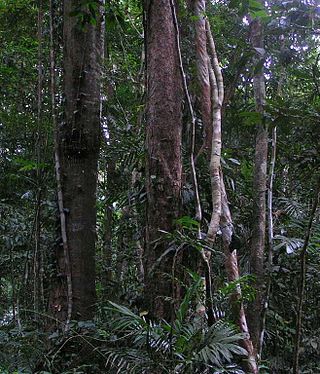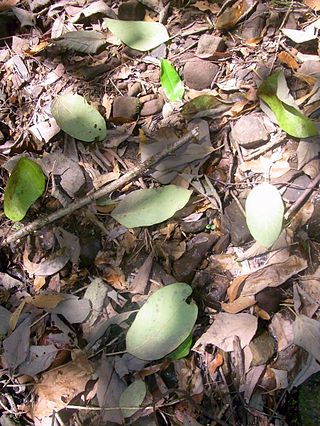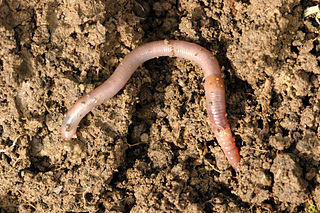Related Research Articles

Tillage is the agricultural preparation of soil by mechanical agitation of various types, such as digging, stirring, and overturning. Examples of human-powered tilling methods using hand tools include shoveling, picking, mattock work, hoeing, and raking. Examples of draft-animal-powered or mechanized work include ploughing, rototilling, rolling with cultipackers or other rollers, harrowing, and cultivating with cultivator shanks (teeth).

Lumbricus terrestris is a large, reddish worm species thought to be native to Western Europe, now widely distributed around the world. In some areas where it is an introduced species, some people consider it to be a significant pest for out-competing native worms.

Tropical rainforests are rainforests that occur in areas of tropical rainforest climate in which there is no dry season – all months have an average precipitation of at least 60 mm – and may also be referred to as lowland equatorial evergreen rainforest. True rainforests are typically found between 10 degrees north and south of the equator ; they are a sub-set of the tropical forest biome that occurs roughly within the 28-degree latitudes. Within the World Wildlife Fund's biome classification, tropical rainforests are a type of tropical moist broadleaf forest that also includes the more extensive seasonal tropical forests.
Silviculture is the practice of controlling the growth, composition/structure, as well as quality of forests to meet values and needs, specifically timber production.

An old-growth forest, sometimes synonymous with primary forest, virgin forest, late seral forest, primeval forest, first-growth forest, or mature forest—is a forest that has attained great age without significant disturbance, and thereby exhibits unique ecological features, and might be classified as a climax community. The Food and Agriculture Organization of the United Nations defines primary forests as naturally regenerated forests of native tree species where there are no clearly visible indications of human activity and the ecological processes are not significantly disturbed. Barely one-third of the world's forests are primary forests. Old-growth features include diverse tree-related structures that provide diverse wildlife habitats that increases the biodiversity of the forested ecosystem. Virgin or first-growth forests are old-growth forests that have never been logged. The concept of diverse tree structure includes multi-layered canopies and canopy gaps, greatly varying tree heights and diameters, and diverse tree species and classes and sizes of woody debris.

Clearcutting, clearfelling or clearcut logging is a forestry/logging practice in which most or all trees in an area are uniformly cut down. Along with shelterwood and seed tree harvests, it is used by foresters to create certain types of forest ecosystems and to promote select species that require an abundance of sunlight or grow in large, even-age stands. Logging companies and forest-worker unions in some countries support the practice for scientific, safety and economic reasons, while detractors consider it a form of deforestation that destroys natural habitats and contributes to climate change. Environmentalists, traditional owners, local residents and others have regularly campaigned against clearcutting, including through the use of blockades and nonviolent direct action.

In forestry, windthrow refers to trees uprooted by wind. Breakage of the tree bole (trunk) instead of uprooting is called windsnap. Blowdown refers to both windthrow and windsnap.

The soil food web is the community of organisms living all or part of their lives in the soil. It describes a complex living system in the soil and how it interacts with the environment, plants, and animals.

Forest ecology is the scientific study of the interrelated patterns, processes, flora, fauna and ecosystems in forests. The management of forests is known as forestry, silviculture, and forest management. A forest ecosystem is a natural woodland unit consisting of all plants, animals, and micro-organisms in that area functioning together with all of the non-living physical (abiotic) factors of the environment.

A hydrosere is a plant succession which occurs in an area of fresh water such as in oxbow lakes and kettle lakes. In time, an area of open freshwater will naturally dry out, ultimately becoming woodland. During this change, a range of different landtypes such as swamp and marsh will succeed each other.

The Atlantic titi monkey or masked titi is a species of titi, a type of New World monkey, endemic to Brazil.
A tree throw or tree hole is a bowl-shaped cavity or depression created in the subsoil by a tree.

Soil biology is the study of microbial and faunal activity and ecology in soil. Soil life, soil biota, soil fauna, or edaphon is a collective term that encompasses all organisms that spend a significant portion of their life cycle within a soil profile, or at the soil-litter interface. These organisms include earthworms, nematodes, protozoa, fungi, bacteria, different arthropods, as well as some reptiles, and species of burrowing mammals like gophers, moles and prairie dogs. Soil biology plays a vital role in determining many soil characteristics. The decomposition of organic matter by soil organisms has an immense influence on soil fertility, plant growth, soil structure, and carbon storage. As a relatively new science, much remains unknown about soil biology and its effect on soil ecosystems.

Rhamnus cathartica, the European buckthorn, common buckthorn, purging buckthorn, or just buckthorn, is a species of small tree in the flowering plant family Rhamnaceae. It is native to Europe, northwest Africa and western Asia, from the central British Isles south to Morocco, and east to Kyrgyzstan. It was introduced to North America as an ornamental shrub in the early 19th century or perhaps before, and is now naturalized in the northern half of the continent, and is classified as an invasive plant in several US states and in Ontario, Canada.

Plant litter is dead plant material that have fallen to the ground. This detritus or dead organic material and its constituent nutrients are added to the top layer of soil, commonly known as the litter layer or O horizon. Litter is an important factor in ecosystem dynamics, as it is indicative of ecological productivity and may be useful in predicting regional nutrient cycling and soil fertility.

Invasive species of earthworms from the suborder Lumbricina have been expanding their range in North America. Their introduction can have marked effects on the nutrient cycles in temperate forests. These earthworms increase the cycling and leaching of nutrients by breaking up decaying organic matter and spreading it into the soil. Since plants native to these northern forests are evolutionarily adapted to the presence of thick layers of decaying organic matter, the introduction of worms can lead to loss of biodiversity as young plants face less nutrient-rich conditions. Some species of trees and other plants may be incapable of surviving such changes in available nutrients. This change in the plant diversity in turn affects other organisms and often leads to increased invasions of other exotic species as well as overall forest decline. They do not require a mate to reproduce, allowing them to spread faster.

Hügelkultur, literally mound bed or mound culture is a horticultural technique where a mound constructed from decaying wood debris and other compostable biomass plant materials is later planted as a raised bed. Adopted by permaculture advocates, it is suggested the technique helps to improve soil fertility, water retention, and soil warming, thus benefitting plants grown on or near such mounds.

Dendrodrilus rubidus is a species of earthworm in the family Lumbricidae. It is native to Europe, and it is a widespread introduced species, occurring on every continent except Antarctica, as well as many islands. It is often invasive. It is sometimes used as fishing bait, and is marketed under many nonspecific names, including red wiggler, jumping red wiggler, red trout worm, jumbo red worm, and pink worm. Other common names include bank worm, tree worm, and gilt tail.

The Japanese temperate rainforest is well sustained and maintains a high biodiversity. One method that has been utilized in maintaining the health of forests in Japan has been afforestation. The Japanese government and private businesses have set up multiple projects to plant native tree species in open areas scattered throughout the country. This practice has resulted in shifts in forest structure and a healthy temperate rainforest that maintains a high biodiversity.

Mor humus is a form of forest floor humus occurring mostly in coniferous forests. Mor humus consists of evergreen needles and woody debris that litter the forest floor. This litter is slow to decompose, in part due to their chemical composition, but also because of the generally cool and wet conditions where mor humus is found. This results in low bacterial activity and an absence of earthworms and other soil fauna. Because of this, most of the organic matter decomposition in mor humus is carried out by fungi.
References
- 1 2 Šamonil, P., Král, K., & Hort, L. (2010). The role of tree uprooting in soil formation: A critical literature review. Geoderma, 157(3–4), 65-79.
- 1 2 Embleton-Hamann, C. (2004). Processes responsible for the development of a pit and mound microrelief. Catena, 57(2), 175-188.
- ↑ Clinton, Barton D; Baker, Corey R (2000). "Catastrophic windthrow in the southern Appalachians: characteristics of pits and mounds and initial vegetation responses". Forest Ecology and Management. 126 (1): 51–60. CiteSeerX 10.1.1.594.2610 . doi:10.1016/s0378-1127(99)00082-1. ISSN 0378-1127.
- ↑ Ulanova, Nina G (2000). "The effects of windthrow on forests at different spatial scales: a review". Forest Ecology and Management. 135 (1–3): 155–167. doi:10.1016/s0378-1127(00)00307-8. ISSN 0378-1127.
- ↑ Kabrick, J.M.; Meyers, N.L.; McSweeney, K. (1997). "Comparison of sampling methods for estimating pit and mound microtopography". Soil Science Society of America Journal. 61 (5): 1423–27. Bibcode:1997SSASJ..61.1423K. doi:10.2136/sssaj1997.03615995006100050021x. ISSN 0361-5995.
- 1 2 Liechty, H. O., Jurgensen, M. F., Mroz, G. D., Gale, M. R., Liechty, H. O., Jurgensen, M. F., et al. (1997). Pit and mound topography and its influence on storage of carbon, nitrogen, and organic matter within an old-growth forest. Canadian Journal of Forest Research, 27(12), 1992.
- 1 2 Peterson, C. J., & Campbell, J. E. (1993). Microsite differences and temporal change in plant communities of treefall pits and mounds in an old-growth forest. Bulletin of the Torrey Botanical Club, 120(4), 451-460.
- ↑ Nachtergale, L.; Ghekiere, K.; De Schrijver, A.; Muys, B.; Luyssaert, S.; Lust, N. (2002). "Earthworm biomass and species diversity in windthrow sites of a temperate lowland forest". Pedobiologia. 46 (5): 440–451. doi:10.1078/0031-4056-00151. ISSN 0031-4056.